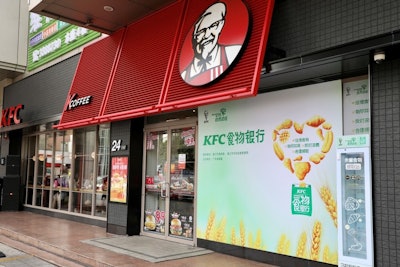
KFC is a big deal in China, and the quick service restaurant chain is poised to soon serve many more Chinese customers.
The U.S.-based brand had its origins in 1930, when Col. Harland Sanders began serving fried chicken out of a gas station in Corbin, Kentucky. From those humble beginnings, the brand now known as KFC operates in more than 150 countries around the world.
The country with the biggest store, however, is not the country where KFC originated. More on that later.
KFC in 2002 became a subsidiary of Yum! Brands, based in the United States. Yum! Brands is also the parent company of Pizza Hut and Taco Bell.
But in 2015, it became apparent that Yum! Brands stores, most notably KFC and Pizza Hut, were so popular in China that another company, Yum China, spun off from the original Yum! Brands and was established one year later.
And while KFC has been in China for 36 years, its presence there has grown substantially since Wat took over as CEO.
Participating in the Fortune podcast Leadership Next, Wat spoke about KFC’s present status in China, while also offering a glimpse of its future.
KFC rapidly growing in China
During the podcast, Wat made a comment that caught the host, Fortune CEO Alan Murray, a little off-guard.
“KFC, after 36 years in China, (operates) in 1,900 cities, only,” she said.
That’s right, she said “only.”
And she also spoke about how in December 2023, the 10,000th KFC store in China opened its doors. For context, according to the KFC website, there are 4,295 locations in the United States.
But Wat explained why she used that word.
“There are still 1,100 cities in China that have zero KFCs,” she said.
She also explained that Pizza Hut “only” operates in 700 Chinese cities.
But Yum China only reaches about one-third of the total Chinese population, Wat said, citing distance from the customer as one of the major problems.
 Joey WatCourtesy Yum China
Joey WatCourtesy Yum China
Yum China is not content with those numbers, and the company is acting to change that. While Wat did not clarify if the company’s near term expansion plans – which are certainly ambitious – involve the establishment of new stores in cities where Yum China operates or in ones where it doesn’t, she did shed light on the pace of the expansion.
“This year alone, we are going to open more than 1,300, maybe 1,400 stores,” she said. “We are at a very fast pace of expansion.”
How American, Chinese KFCs differ
When asked how a KFC store in China compares to one in the United States, Wat said they are “rather different.”
Unlike is the case in the United States, KFC has a “very big breakfast business” in China.
She also pointed out that a much higher percentage of the food sold in Chinese KFC locations is not fried.
“(During breakfast), 90% of the food there is not from the fryer. For the normal meal, 60% is from the oven, and this is rather unique, because not all of the KFCs outside of China have ovens in their kitchens,” she said. “We can have such a good mix of food because we have the cooking equipment.”
Other differences are that whole chickens are available at KFC stores in China, as well as beef burgers.
KFC China’s menu options also transcend cultures, which has made it popular there.
“The menu is good food. It doesn’t matter if it is American food or Chinese food or southeast Asian food,” Wat said.
That isn’t just the case for KFC China. Wat also pointed out a similar situation at Yum China’s Pizza Hut locations.
“The biggest selling pizza in Pizza Hut China is actually Korean pizza” Wat said.
















